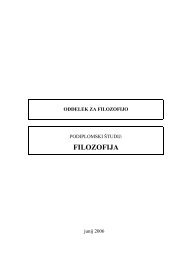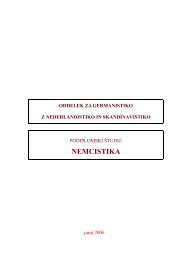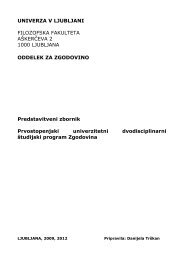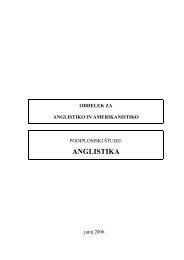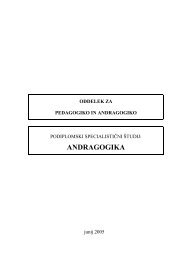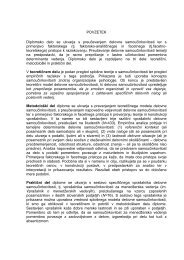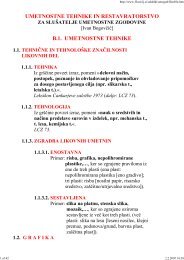B_solo_zgibanke male new_1 - Filozofska fakulteta
B_solo_zgibanke male new_1 - Filozofska fakulteta
B_solo_zgibanke male new_1 - Filozofska fakulteta
Create successful ePaper yourself
Turn your PDF publications into a flip-book with our unique Google optimized e-Paper software.
the discourse function of intonation does not concern so much the syntax as it<br />
does the relationship between the interlocutors, on the one hand, and between the<br />
speaker and the message, on the other. Conversation analysis, which generally<br />
observes the speakers’ behaviour in the turn-taking strategies, tries to find prosodic<br />
means which the participants in a spoken interaction employ to signal different<br />
degrees of cooperativeness or uncooperativeness. important work on the function of<br />
different prosodic features in conversation and in particular in turn-taking was done<br />
by Couper-kuhlen (1986, 1993) and Couper-kuhlen and Selting (1996). they<br />
illustrated how intonation reflects the orderly, as well as in orderly turn-taking and<br />
supportive, as well as non-supportive backchannelling.<br />
another aspect of the discourse function of intonation concerns cohesion.<br />
although it is generally believed that cohesive ties are realized by different<br />
grammatical and lexical references, it is plausible to claim that different prosodic<br />
features may play an equally important role in achieving cohesion in spoken<br />
discourse. the pioneering and seminal work was carried out by Brazil (1997) who<br />
established that the prosodic features of ‘tone’, ‘key’ and ‘termination’ play an<br />
important part in expressing cohesion in speech. the ‘referring’ tones (i.e. the<br />
fall-rise, the rise) are to express the anaphoric reference to everything that is shared<br />
by the interlocutors, whereas the ‘proclaiming’ tones (i.e. the fall, the rise-fall) are<br />
usually used to express cataphoric reference, i.e. to introduce <strong>new</strong> information. key<br />
and termination are used to establish contrastive or equivalent meaningful relations<br />
between two pieces of information where the high key is used to express the former<br />
and the mid key the latter. the function of termination is primarily to limit and<br />
predict the addressee’s response: the high termination is said to encourage further<br />
conversation, while the low termination indicates the possible end of conversation.<br />
the pragmatic function of intonation is by far most elusive and difficult to<br />
describe. it concerns the relationship between the speaker meaning and the surface<br />
meaning of an utterance which is very context-dependent. Speakers, when they find<br />
out that there is a mismatch between the content of an utterance and the context in<br />
which it is conveyed, are usually bewildered. the same may happen when they<br />
realise that there is a disagreement between the intonation of the message and the<br />
context in which it is delivered.<br />
the pragmatic function of intonation has been the preoccupation of a number of<br />
renowned linguists (Crystal/Davy, 1975, O’Connor/arnold, 1975) who have tried to<br />
establish the predicted attitudinal meanings of intonation in a particular context.<br />
the result was a mass of different labels, each referring to a different attitude or<br />
emotion. the terms ‘attitude’ and ‘emotion’ were often used synonymously, thus<br />
causing even greater disorder. Couper-kuhlen (1986: 185–7) has suggested a<br />
distinction between emotion and attitude. For her ‘emotion’ is a speaker’s state of<br />
being (e.g. happy, sad, angry etc.) whereas ‘attitude’ refers to a kind of behaviour (e.g.<br />
being friendly, kind, condescending etc). Wichmann (2000: 145) has argued that<br />
there are some attitudes which cannot fall in the category of behaviour but are better<br />
described as opinions, beliefs or knowledge about something (e.g. being critical of,<br />
216





